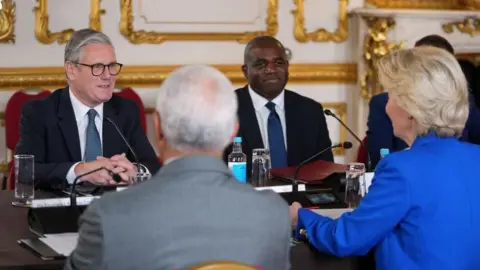The recent agreement between the United Kingdom and the European Union marks a pivotal moment in what has been an arduous journey since Brexit. Political editor Chris Mason offers insightful commentary on this evolving relationship, emphasizing the deeply entrenched unease that persists even amidst newfound arrangements. As such, this deal serves not only as a resurgence of negotiations but as a reminder of the complex nature of UK-EU relations in a post-Brexit context.
Initially, the British government imposed self-regulating “guardrails” during negotiations that deliberately constricted its flexibility. This self-imposed limitation reflects a broader strategy — a resolute commitment to avoid rejoining the EU’s customs union, participating in the single market, or reinstating freedom of movement for citizens. As a result, the current deal risks disappointing both hardline Brexiteers, who see any concession as a dilution of the original Brexiteer sentiments, and those who have lamented Brexit as a misstep, perceiving the ministers as insufficiently ambitious.
Sir Keir Starmer, the leader of the UK Labour Party, seems to navigate through these conflicting sentiments strategically. He appears to believe that a significant portion of the populace is neither staunchly pro-Brexit nor fervently against it, but rather prefers to see what they might term “improvements” to existing agreements. Initial reactions from the government suggest a positive reception, as Prime Minister Starmer communicated optimism regarding enhanced trading relations with major economies, including the United States and India, as well as with the EU. The potential implications for job preservation in key sectors like automotive manufacturing are notable outcomes of the negotiations.
As outlined in the discussions, the deal with the EU primarily focuses on reducing barriers to trade. However, many specific details — such as timeframes and costs — remain unresolved. Observers note that while this deal seeks to ease tensions surrounding Brexit, it is also crucial to recognize the challenges it brings. Some proponents argue that it represents a vital step in normalizing trade, while critics worry it signifies permanent compromises with EU regulations, particularly “dynamic alignment.” This acceptance of evolving EU rules is viewed by some as a critical loss of sovereignty.
Ursula von der Leyen, President of the European Commission, highlighted that the acceptance of such trade-offs was the UK’s choice. Yet despite the arguments encapsulated within this negotiation process, there remains a sense that the contentious debates from the Brexit era may recede into the background. Nevertheless, the ongoing conversations and negotiations about practical implications will undoubtedly be significant, potentially affecting various sectors including defense cooperation and youth travel.
As a marker of the near-term future, the anticipated UK-EU summit is scheduled to become an annual event, which signifies both continuity in cooperation and mirrors a historical context of unease that predates Brexit. This relationship has been marked by periods of tension even when the UK was a member of the EU, and now, it extends into a new phase as a non-member state. The government’s narrative depicts this deal as a “reset,” yet it appears that the solutions being pursued may lean towards a more permanent restructuring of ties with the EU.
In conclusion, Mason suggests that while the current government is inclined to cultivate closer relations, future administrations may diverge in their approach. Therefore, the evolution of this UK-EU relationship will be dictated by both the outcomes of ongoing negotiations and the broader political landscape in the UK. In a post-Brexit world, it remains to be seen how these changes will influence the daily lives of citizens and the operational dynamics of trade and cooperation between the UK and its European neighbors.



